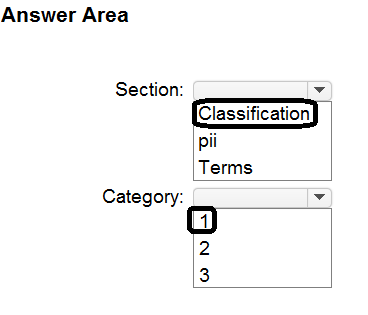| Question.46 HOTSPOT You are building an app that will answer customer calls about the status of an order. The app will query a database for the order details and provide the customers with a spoken response. You need to identify which Azure AI service APIs to use. The solution must minimize development effort. Which object should you use for each requirement? To answer, select the appropriate options in the answer area. NOTE: Each correct selection is worth one point. 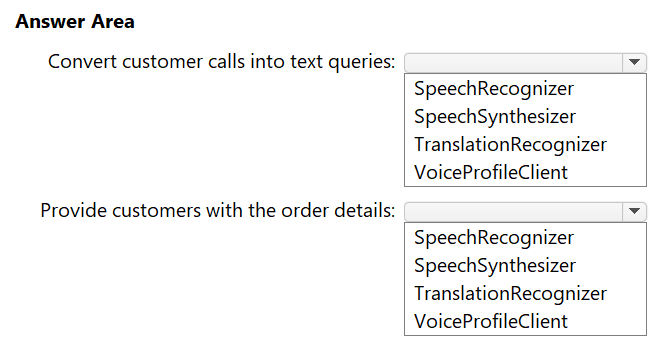 |
46. Click here to View Answer
Answer:
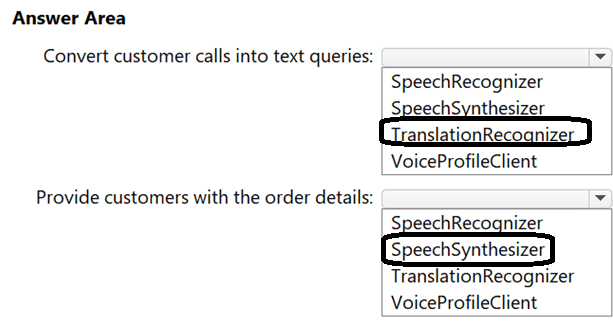
| Question.47 HOTSPOT You are building an app that will enable users to upload images. The solution must meet the following requirements: * Automatically suggest alt text for the images. * Detect inappropriate images and block them. * Minimize development effort. You need to recommend a computer vision endpoint for each requirement. What should you recommend? To answer, select the appropriate options in the answer area. NOTE: Each correct selection is worth one point. Hot Area: 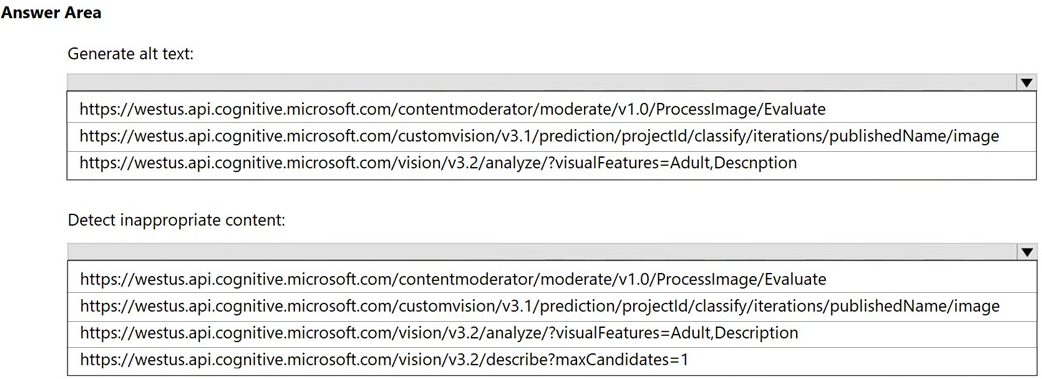 |
47. Click here to View Answer
Answer:
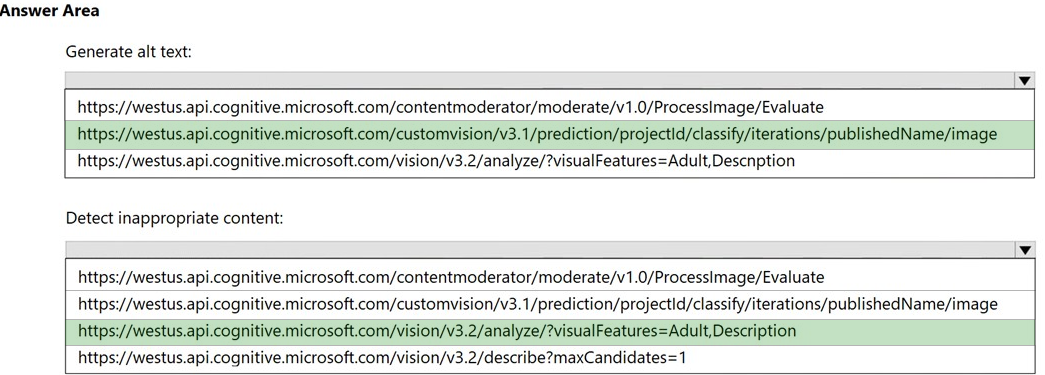
Box 1: https://westus.api.cognitive.microsoft.com/customvision/v3.1/prediction/projectid/classify/iterations/publishName/image
Box 2: https://westus.api.cognitive.microsoft.com/vision/v3.2/analyze/?visualFeatures=Adult,Description
Computer Vision can detect adult material in images so that developers can restrict the display of these images in their software. Content flags are applied with a score between zero and one so developers can interpret the results according to their own preferences.
You can detect adult content with the Analyze Image API. When you add the value of Adult to the visualFeatures query parameter
Incorrect:
Use the Image Moderation API in Azure Content Moderator to scan image content. The moderation job scans your content for profanity, and compares it against custom and shared blocklists.
Reference:
https://docs.microsoft.com/en-us/azure/cognitive-services/computer-vision/concept-detecting-adult-content https://docs.microsoft.com/en-us/azure/cognitive-services/content-moderator/try-image-api https://docs.microsoft.com/en-us/legal/cognitive-services/custom-vision/custom-vision-cvs-transparency-note
| Question.48 DRAG DROP You are building a Language Understanding model for purchasing tickets. You have the following utterance for an intent named PurchaseAndSendTickets. Purchase [2 audit business] tickets to [Paris] [next Monday] and send tickets to [email@domain.com] You need to select the entity types. The solution must use built-in entity types to minimize training data whenever possible. Which entity type should you use for each label? To answer, drag the appropriate entity types to the correct labels. Each entity type may be used once, more than once, or not at all. You may need to drag the split bar between panes or scroll to view content. Select and Place: 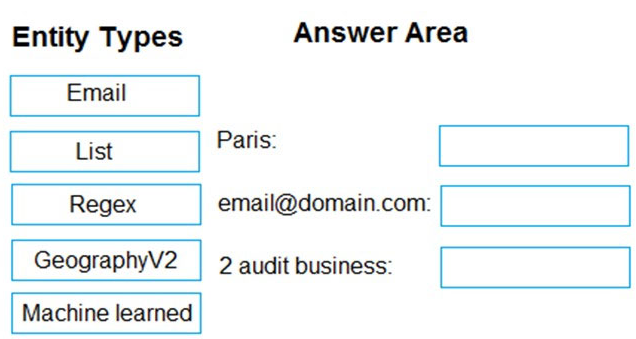 |
48. Click here to View Answer
Answer:
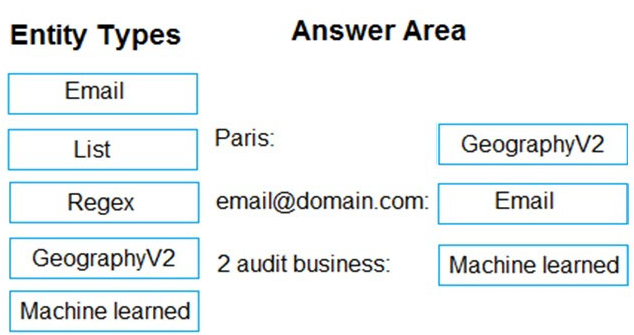
Box 1: GeographyV2 –
The prebuilt geographyV2 entity detects places. Because this entity is already trained, you do not need to add example utterances containing GeographyV2 to the application intents.
Box 2: Email –
Email prebuilt entity for a LUIS app: Email extraction includes the entire email address from an utterance. Because this entity is already trained, you do not need to add example utterances containing email to the application intents.
Box 3: Machine learned –
The machine-learning entity is the preferred entity for building LUIS applications.
Reference:
https://docs.microsoft.com/en-us/azure/cognitive-services/luis/luis-reference-prebuilt-geographyv2 https://docs.microsoft.com/en-us/azure/cognitive-services/luis/luis-reference-prebuilt-email https://docs.microsoft.com/en-us/azure/cognitive-services/luis/reference-entity-machine-learned-entity
| Question.49 You use the Microsoft Bot Framework Composer to build a chatbot that enables users to purchase items. You need to ensure that the users can cancel in-progress transactions. The solution must minimize development effort. What should you add to the bot? A. a language generator B. a custom event C. a dialog trigger D. a conversation activity |
49. Click here to View Answer
Answer: D
Handling interruptions is an important aspect of a robust bot. Users will not always follow your defined conversation flow, step by step. They may try to ask a question in the middle of the process, or simply want to cancel it instead of completing it.
Example:
If the user types cancel, it calls CancelAllDialogsAsync on its inner dialog context, which clears its dialog stack and causes it to exit with a canceled status and no result value. To the MainDialog (shown later on), it will appear that the booking dialog ended and returned null, similar to when the user chooses not to confirm their booking. private async Task<DialogTurnResult> InterruptAsync(DialogContext innerDc, CancellationToken cancellationToken)
{
if (innerDc.Context.Activity.Type == ActivityTypes.Message)
{
var text = innerDc.Context.Activity.Text.ToLowerInvariant();
switch (text)
{
case cancel:
case quit:
var cancelMessage = MessageFactory.Text(CancelMsgText, CancelMsgText, InputHints.IgnoringInput); await innerDc.Context.SendActivityAsync(cancelMessage, cancellationToken); return await innerDc.CancelAllDialogsAsync(cancellationToken);
}
}
return null;
}
Reference:
https://docs.microsoft.com/en-us/azure/bot-service/bot-builder-howto-handle-user-interrupt
| Question.50 HOTSPOT You are building a chatbot. You need to use the Content Moderator service to identify messages that contain sexually explicit language. Which section in the response from the service will contain the category score, and which category will be assigned to the message? To answer, select the appropriate options in the answer area. NOTE: Each correct selection is worth one point.  |
50. Click here to View Answer
Answer:
